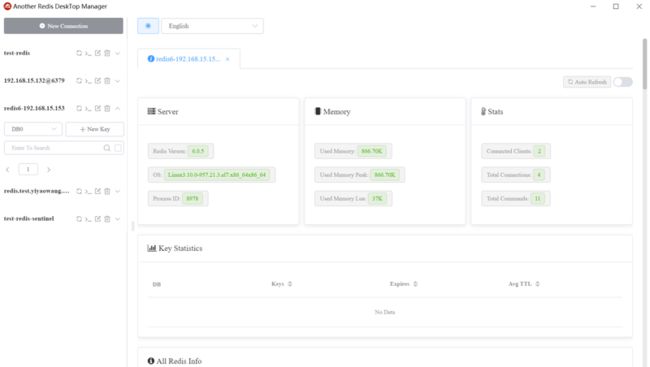一、源码安装redis
1、下载redis源码包
cd /usr/local
#官网获取redis源码包
wget http://download.redis.io/releases/redis-6.0.5.tar.gz说明:如果尚未安装wget命令,请先安装wget命令
yum install -y wget2、安装redis相关依赖
redis使用C语言写的,在编译源码的时候需要gcc,redis-6.x版本对gcc版本是有要求的,gcc版本不要低于5.3。
- 查看gcc版本
gcc -v[root@localhost local]# gcc -v
Using built-in specs.
COLLECT_GCC=gcc
COLLECT_LTO_WRAPPER=/opt/rh/devtoolset-9/root/usr/libexec/gcc/x86_64-redhat-linux/9/lto-wrapper
Target: x86_64-redhat-linux
Configured with: ../configure --enable-bootstrap --enable-languages=c,c++,fortran,lto --prefix=/opt/rh/devtoolset-9/root/usr --mandir=/opt/rh/devtoolset-9/root/usr/share/man --infodir=/opt/rh/devtoolset-9/root/usr/share/info --with-bugurl=http://bugzilla.redhat.com/bugzilla --enable-shared --enable-threads=posix --enable-checking=release --enable-multilib --with-system-zlib --enable-__cxa_atexit --disable-libunwind-exceptions --enable-gnu-unique-object --enable-linker-build-id --with-gcc-major-version-only --with-linker-hash-style=gnu --with-default-libstdcxx-abi=gcc4-compatible --enable-plugin --enable-initfini-array --with-isl=/builddir/build/BUILD/gcc-9.3.1-20200408/obj-x86_64-redhat-linux/isl-install --disable-libmpx --enable-gnu-indirect-function --with-tune=generic --with-arch_32=x86-64 --build=x86_64-redhat-linux
Thread model: posix
gcc version 9.3.1 20200408 (Red Hat 9.3.1-2) (GCC)- yum安装gcc等依赖
yum -y install centos-release-scl
yum -y install devtoolset-9-gcc devtoolset-9-gcc-c++ devtoolset-9-binutils
#scl命令启用只是临时的,退出shell或重启就会恢复原系统gcc版本
scl enable devtoolset-9 bash
#写入系统执行脚本文件,永久生效
echo "source /opt/rh/devtoolset-9/enable" >>/etc/profile3、编译安装redis
#进入源码压缩包所在目录
cd /usr/local/
#解压redis源码压缩包
tar -zxvf ./redis-6.0.5.tar.gz
#进入redis源码包目录
cd /usr/local/redis-6.0.5
#编译redis源码并安装
make && make install- 编译安装其它命令
# 编译出错时,清出编译生成的文件
make distclean
# 编译安装到指定目录下
make PREFIX=/usr/local/redis install
# 卸载
make uninstall4、配置redis自启动
1、通过systemctl配置自启动
- 修改redis.conf配置文件
vim /usr/local/redis-6.0.5/redis.conf#默认绑定本地回环地址,可注释本配置,开放远程ip可以访问,或者指定对应的远程ip
#bind 127.0.0.1
#设置密码
requirepass 123456
#表示以后台守护进程方式启动服务,默认值为no
daemonize yes
#表示以 CentOS systemd 系统服务方式启动,默认值为no
supervised systemd
#指定日志文件目录,注意此目录需要真实存在,否则redis启动报错
logfile "/var/log/redis/redis-server.log"- 创建 redis-server.service 文件
#进入systemd服务配置加载目录
cd /etc/systemd/system
#创建redis服务配置文件
touch redis-server.service
#改变文件权限,此处为最大权限,酌情而定
chmod 777 ./redis-server.service- redis-server.service文件配置内容
# example systemd service unit file for redis-server
#
# In order to use this as a template for providing a redis service in your
# environment, _at the very least_ make sure to adapt the redis configuration
# file you intend to use as needed (make sure to set "supervised systemd"), and
# to set sane TimeoutStartSec and TimeoutStopSec property values in the unit's
# "[Service]" section to fit your needs.
#
# Some properties, such as User= and Group=, are highly desirable for virtually
# all deployments of redis, but cannot be provided in a manner that fits all
# expectable environments. Some of these properties have been commented out in
# this example service unit file, but you are highly encouraged to set them to
# fit your needs.
#
# Please refer to systemd.unit(5), systemd.service(5), and systemd.exec(5) for
# more information.
[Unit]
Description=Redis data structure server
Documentation=https://redis.io/documentation
#Before=your_application.service another_example_application.service
#AssertPathExists=/var/lib/redis
[Service]
#ExecStart=/usr/local/bin/redis-server --supervised systemd --daemonize yes
## Alternatively, have redis-server load a configuration file:
#ExecStart=/usr/local/bin/redis-server /path/to/your/redis.conf
ExecStart=/usr/local/bin/redis-server /usr/local/redis-6.0.5/redis.conf
ExecStop=/usr/local/bin/redis-cli shutdown
Restart=always
LimitNOFILE=10032
NoNewPrivileges=yes
#OOMScoreAdjust=-900
#PrivateTmp=yes
#Type=notify
# 注意 notify 会失败,换成 forking 方式启动,让主进程复制一个子进程的方式执行
Type=forking
#TimeoutStartSec=100
#TimeoutStopSec=100
UMask=0077
#User=root
#Group=root
#WorkingDirectory=/var/lib/redis
[Install]
WantedBy=multi-user.target说明:需要注意的是,ExecStart与ExecStop的配置需要必须符合你本地的实际情况
- 重新加载系统服务文件
systemctl daemon-reload- 以系统服务方式启动 redis-server
systemctl start redis-server.service- 设置redis服务开机自启动
systemctl enable redis-server.service![]()
- 查看服务状态
systemctl status redis-server.service- 查看redis默认的6379端口是否监听
netstat -tlnp | grep 6379![]()
- 查看redis日志
cat /var/log/redis/redis-server.log说明:从redis启动日志中发现,有三条警告日志,下面将尝试解决这些警告。
5、解决redis启动日志中的警告问题
1、backlog socket的监听队列过小警告
WARNING: The TCP backlog setting of 511 cannot be enforced because /proc/sys/net/core/somaxconn is set to the lower value of 128.- 解决方式一
#临时设置生效
sysctl -w net.core.somaxconn = 1024- 解决方式二
vim /etc/sysctl.conf
#在/etc/sysctl.conf文件中增加一行配置
#这是一个kernel参数,表示socket监听的backlog上限
net.core.somaxconn=1024sysctl -p说明:backlog是socket的监听队列,当一个请求(request)尚未被处理或建立时,他会进入backlog,而socket server会处理backlog队列中的请求,被处理掉的请求会被移出队列,当处理速度跟不上请求创建的速度时,队列满后,新来的请求会被拒绝掉。对于一个经常处理新连接的高负载 web服务环境来说,默认的 128 太小了。大多数环境这个值建议增加到 1024 或者更多。
2、内存分配策略警告
WARNING overcommit_memory is set to 0! Background save may fail under low memory condition. To fix this issue add 'vm.overcommit_memory = 1' to /etc/sysctl.conf and then reboot or run the command 'sysctl vm.overcommit_memory=1' for this to take effect.- 解决方式一
#临时设置生效
sysctl -w vm.overcommit_memory = 1- 解决方式二
vim /etc/sysctl.conf
#在/etc/sysctl.conf文件中增加一行配置
#这是一个kernel参数,设置内存分配策略
#vm.overcommit_memory参数有三个选项,分别是0,1,2
#0:表示内核将检查是否有足够的可用内存供应用进程使用;如果有足够的可用内存,内存申请允许;否则,内存申请失败,并把错误返回给应用进程
#1:表示内核允许分配所有的物理内存,而不管当前的内存状态如何
#2:表示内核允许分配超过所有物理内存和交换空间总和的内存
vm.overcommit_memory = 1sysctl -p3、透明大页(Transparent Huge Pages)问题
- 解决方式一
#临时设置生效
echo never > /sys/kernel/mm/transparent_hugepage/enabled透明大页被临时禁用了
- 解决方式二
vim /etc/rc.local
#在/etc/rc.local文件中增加如下脚本
if test -f /sys/kernel/mm/redhat_transparent_hugepage/enabled; then
echo never > /sys/kernel/mm/redhat_transparent_hugepage/enabled
fi说明:linux内核中启用了透明大页的支持,默认是启用的,对于redis来说,将造成redis的延迟和内存使用问题,redis需要禁用透明大页。
- 重启redis服务
systemctl restart redis-server.service说明:重启后再次查看日志,发现以上三条警告日志消失了。
6、防火墙开放redis服务端口
- 查看开放的端口号
firewall-cmd --list-all- 设置开放端口号
firewall-cmd --add-port=6379/tcp --permanent- 重启防火墙
firewall-cmd --reload7、远程测试连接redis服务
1、使用自带的redis-cli客户端测试
#进入redis-cli客户端
/usr/local/bin/redis-cli
#由于redis开启了密码验证,此处需要验证密码
auth 123456
#执行ping命令
ping2、采用第三方客户端测试
推荐一个比较好用并且界面美观的图形化redis客户端(AnotherRedisDesktopManager),前往GitHub下载







